 The site plan encapsulates the present state of affairs, delineating urbanized land, forested areas, streams converging into Lost Lagoon, the prominent causeway, noise pollution sources, and the intricate network of human circulation pathways—both pedestrian and vehicular. Each element intricately influences the edge conditions, shaping the living space for various species. Urban encroachment and land use directly impact biodiversity, altering the delicate balance of ecosystems. The water dynamics, with streams feeding into Lost Lagoon, play a pivotal role in sustaining aquatic life. Noise pollution poses a threat to the acoustic environment, impacting wildlife behavior. Human circulation patterns, on foot and by vehicle, introduce disturbances to the natural landscape. The marsh conditions, susceptible to alterations, further underscore the interconnected relationship between the diverse elements, highlighting the delicate coexistence of urban infrastructure and the ecological integrity of Lost Lagoon.
The site plan encapsulates the present state of affairs, delineating urbanized land, forested areas, streams converging into Lost Lagoon, the prominent causeway, noise pollution sources, and the intricate network of human circulation pathways—both pedestrian and vehicular. Each element intricately influences the edge conditions, shaping the living space for various species. Urban encroachment and land use directly impact biodiversity, altering the delicate balance of ecosystems. The water dynamics, with streams feeding into Lost Lagoon, play a pivotal role in sustaining aquatic life. Noise pollution poses a threat to the acoustic environment, impacting wildlife behavior. Human circulation patterns, on foot and by vehicle, introduce disturbances to the natural landscape. The marsh conditions, susceptible to alterations, further underscore the interconnected relationship between the diverse elements, highlighting the delicate coexistence of urban infrastructure and the ecological integrity of Lost Lagoon. This analysis emphasizes key site observations that distinguish instances of current edge condition failure versus the habitat restoration efforts.
This analysis emphasizes key site observations that distinguish instances of current edge condition failure versus the habitat restoration efforts. This analysis through charcoal rubbing discerns textures associated with both natural forces and human-built elements present on the site while capturing the nuanced surfaces and edge conditions, documenting their imprints within the landscape.
This analysis through charcoal rubbing discerns textures associated with both natural forces and human-built elements present on the site while capturing the nuanced surfaces and edge conditions, documenting their imprints within the landscape.
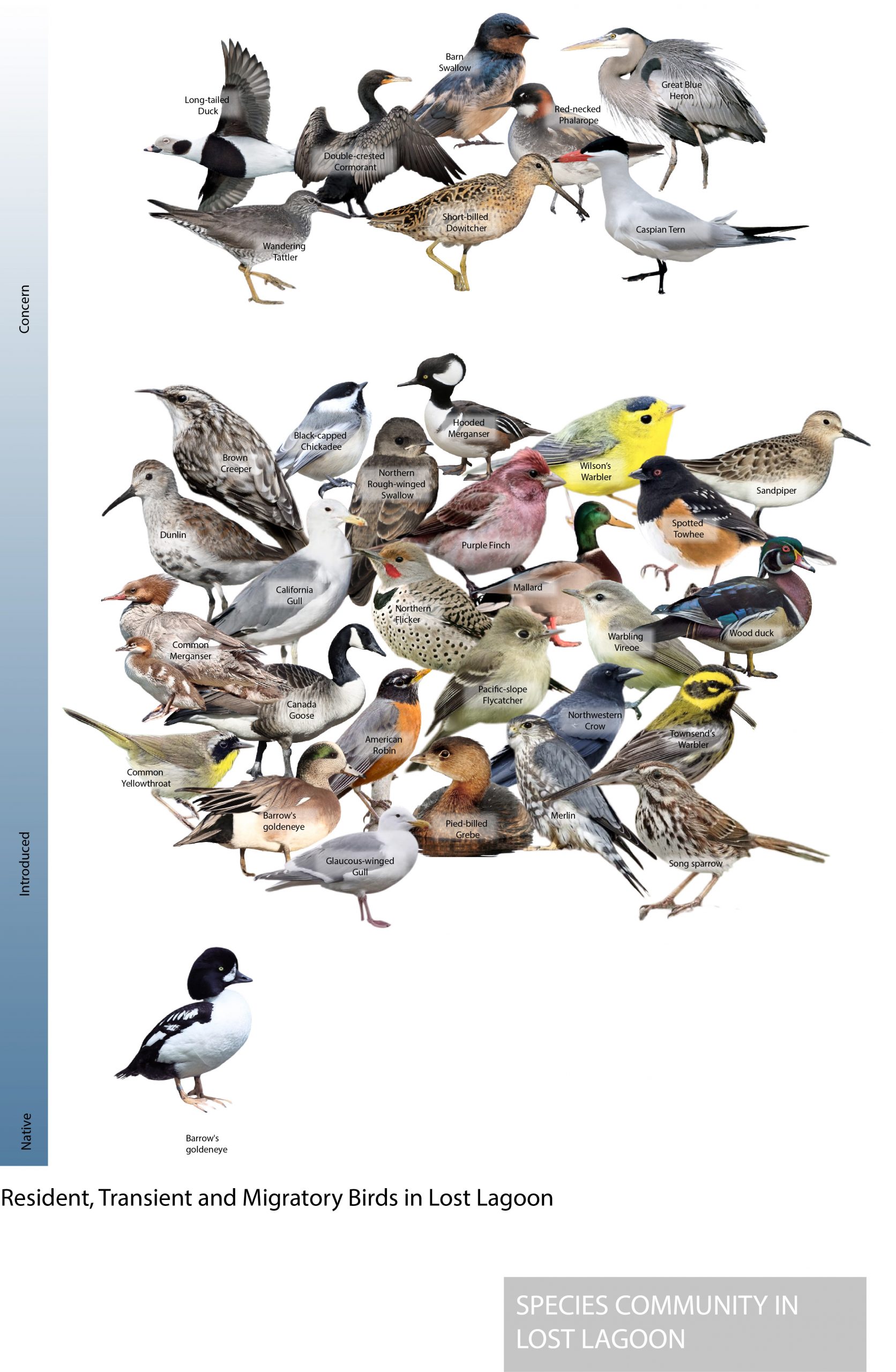

 These diagrams show the species community observed, introduced, and threatened at lost lagoon
These diagrams show the species community observed, introduced, and threatened at lost lagoon
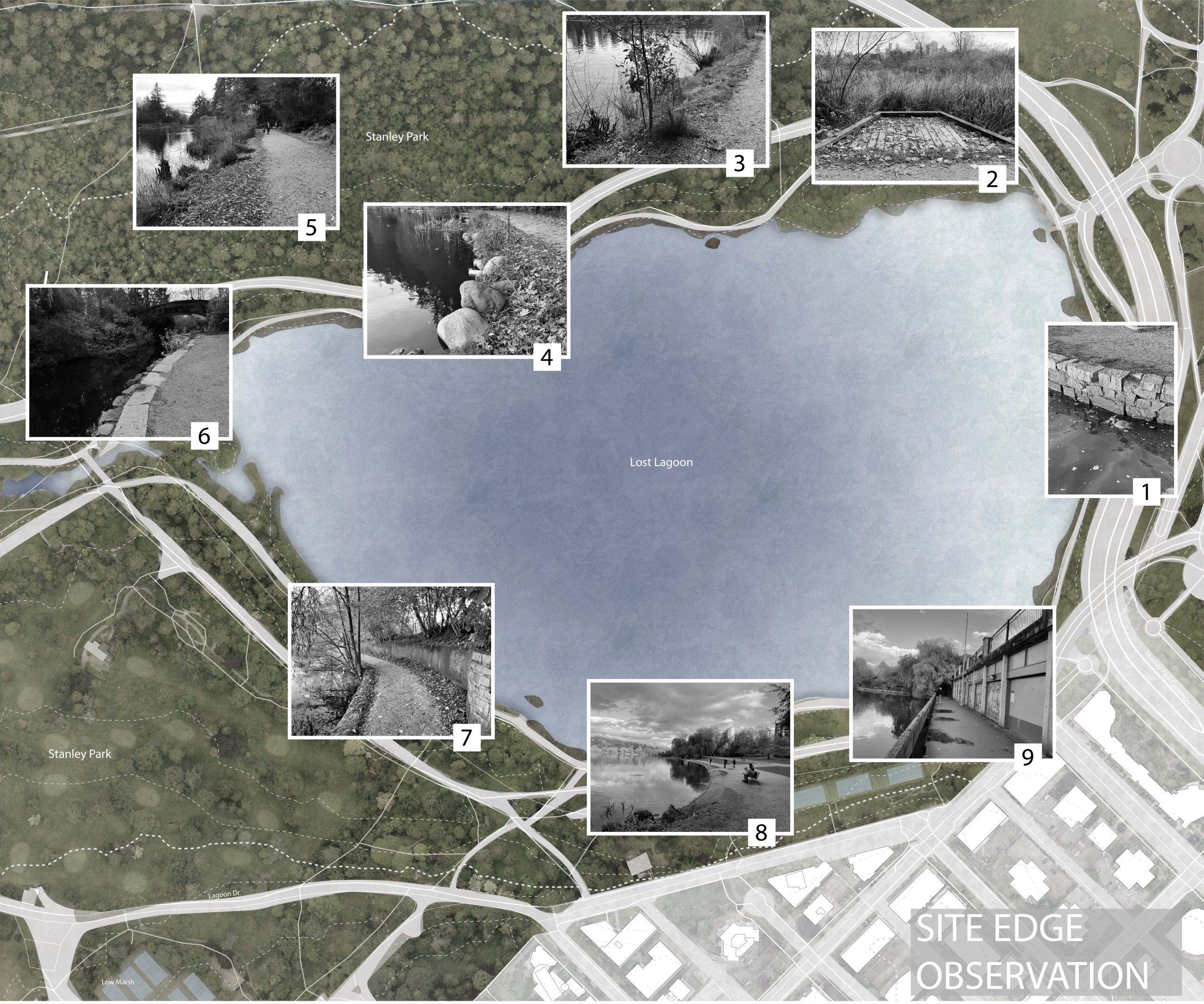
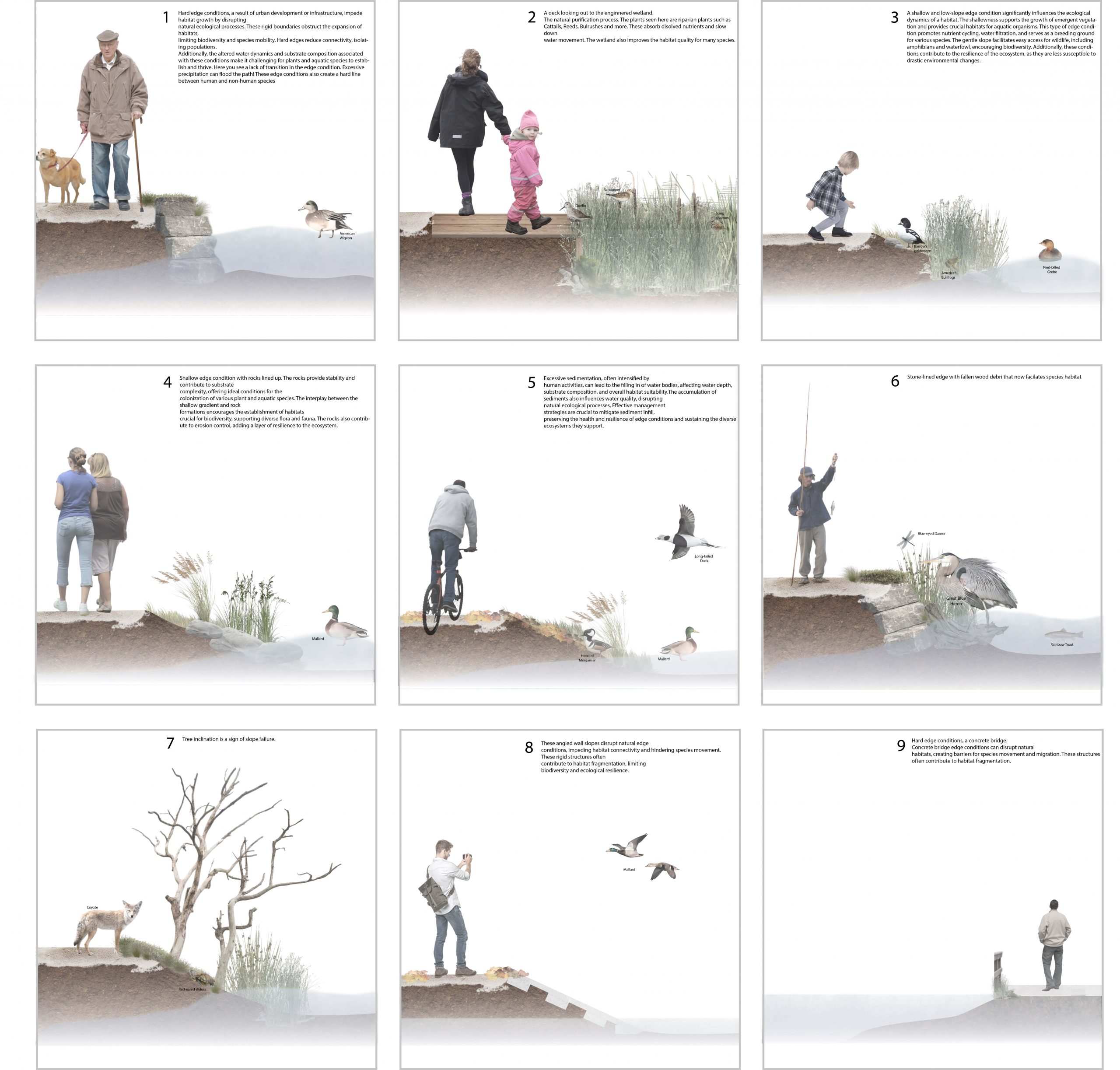 This diagram shows current edge conditions and how these conditions impact species habitat
This diagram shows current edge conditions and how these conditions impact species habitat

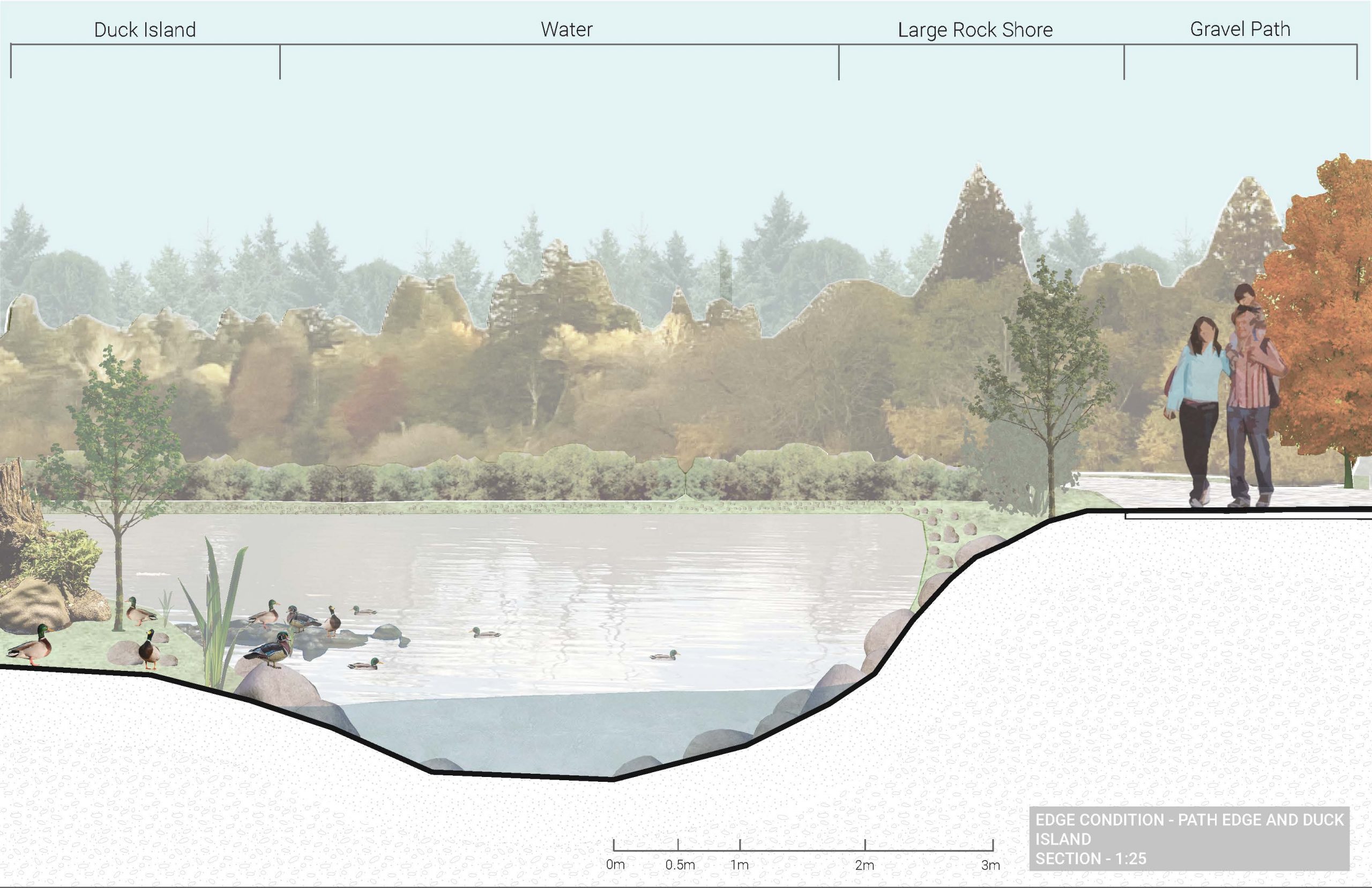
 These sections reflect distinct environmental conditions, with edged conditions shaped by human interventions and naturally formed regions. Our research involved a detailed examination of the vegetation and wildlife distribution, revealing a notable concentration in the northern part of the lake. The two bottom sections are characterized by dense forests, serene nature paths, and rocky edge conditions,while the two top sections contrasts with the more human-developed areas like the Lost Lagoon boardwalk and the concrete slopes on its opposite side.
Upon close observation, we noted a significant disparity in wildlife activity, with the northern, forested region exhibiting a higher presence. In contrast, the human-developed areas, particularly the boardwalk and concrete slopes, not only attract more people but also experience elevated noise levels due to their proximity to Vancouver's buildings. This heightened human impact and increased noise levels seem to discourage wildlife from inhabiting these areas, creating a marked difference compared to the quieter, tree-filled northern part of the lake, which provides more tranquil and reflective viewpoints.
These sections reflect distinct environmental conditions, with edged conditions shaped by human interventions and naturally formed regions. Our research involved a detailed examination of the vegetation and wildlife distribution, revealing a notable concentration in the northern part of the lake. The two bottom sections are characterized by dense forests, serene nature paths, and rocky edge conditions,while the two top sections contrasts with the more human-developed areas like the Lost Lagoon boardwalk and the concrete slopes on its opposite side.
Upon close observation, we noted a significant disparity in wildlife activity, with the northern, forested region exhibiting a higher presence. In contrast, the human-developed areas, particularly the boardwalk and concrete slopes, not only attract more people but also experience elevated noise levels due to their proximity to Vancouver's buildings. This heightened human impact and increased noise levels seem to discourage wildlife from inhabiting these areas, creating a marked difference compared to the quieter, tree-filled northern part of the lake, which provides more tranquil and reflective viewpoints.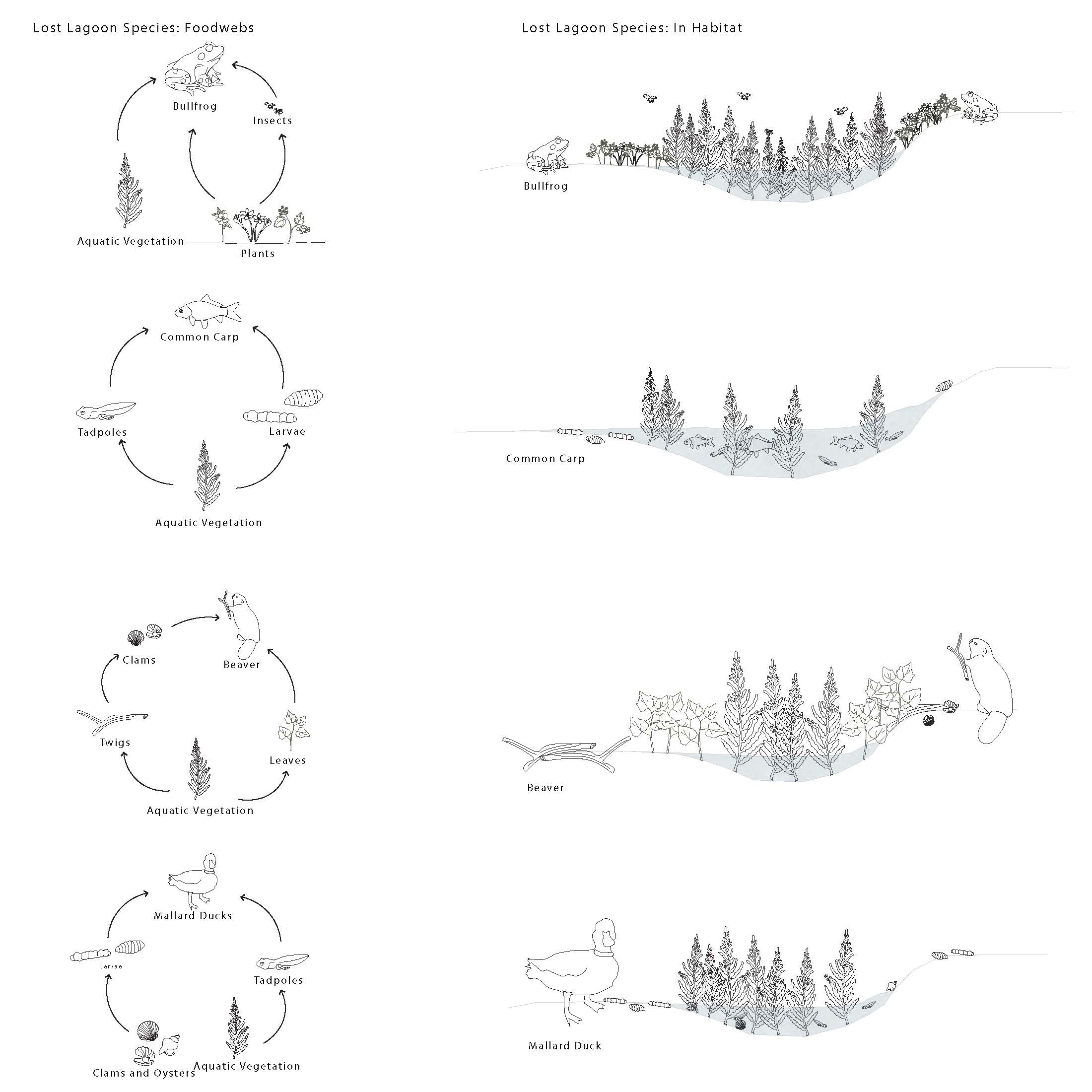



The site plan encapsulates the present state of affairs, delineating urbanized land, forested areas, streams converging into Lost Lagoon, the prominent causeway, noise pollution sources, and the intricate network of human circulation pathways—both pedestrian and vehicular. Each element intricately influences the edge conditions, shaping the living space for various species. Urban encroachment and land use directly impact biodiversity, altering the delicate balance of ecosystems. The water dynamics, with streams feeding into Lost Lagoon, play a pivotal role in sustaining aquatic life. Noise pollution poses a threat to the acoustic environment, impacting wildlife behavior. Human circulation patterns, on foot and by vehicle, introduce disturbances to the natural landscape. The marsh conditions, susceptible to alterations, further underscore the interconnected relationship between the diverse elements, highlighting the delicate coexistence of urban infrastructure and the ecological integrity of Lost Lagoon.
This analysis emphasizes key site observations that distinguish instances of current edge condition failure versus the habitat restoration efforts.
This analysis through charcoal rubbing discerns textures associated with both natural forces and human-built elements present on the site while capturing the nuanced surfaces and edge conditions, documenting their imprints within the landscape.



These diagrams show the species community observed, introduced, and threatened at lost lagoon

This diagram shows current edge conditions and how these conditions impact species habitat



These sections reflect distinct environmental conditions, with edged conditions shaped by human interventions and naturally formed regions. Our research involved a detailed examination of the vegetation and wildlife distribution, revealing a notable concentration in the northern part of the lake. The two bottom sections are characterized by dense forests, serene nature paths, and rocky edge conditions,while the two top sections contrasts with the more human-developed areas like the Lost Lagoon boardwalk and the concrete slopes on its opposite side. Upon close observation, we noted a significant disparity in wildlife activity, with the northern, forested region exhibiting a higher presence. In contrast, the human-developed areas, particularly the boardwalk and concrete slopes, not only attract more people but also experience elevated noise levels due to their proximity to Vancouver's buildings. This heightened human impact and increased noise levels seem to discourage wildlife from inhabiting these areas, creating a marked difference compared to the quieter, tree-filled northern part of the lake, which provides more tranquil and reflective viewpoints.



